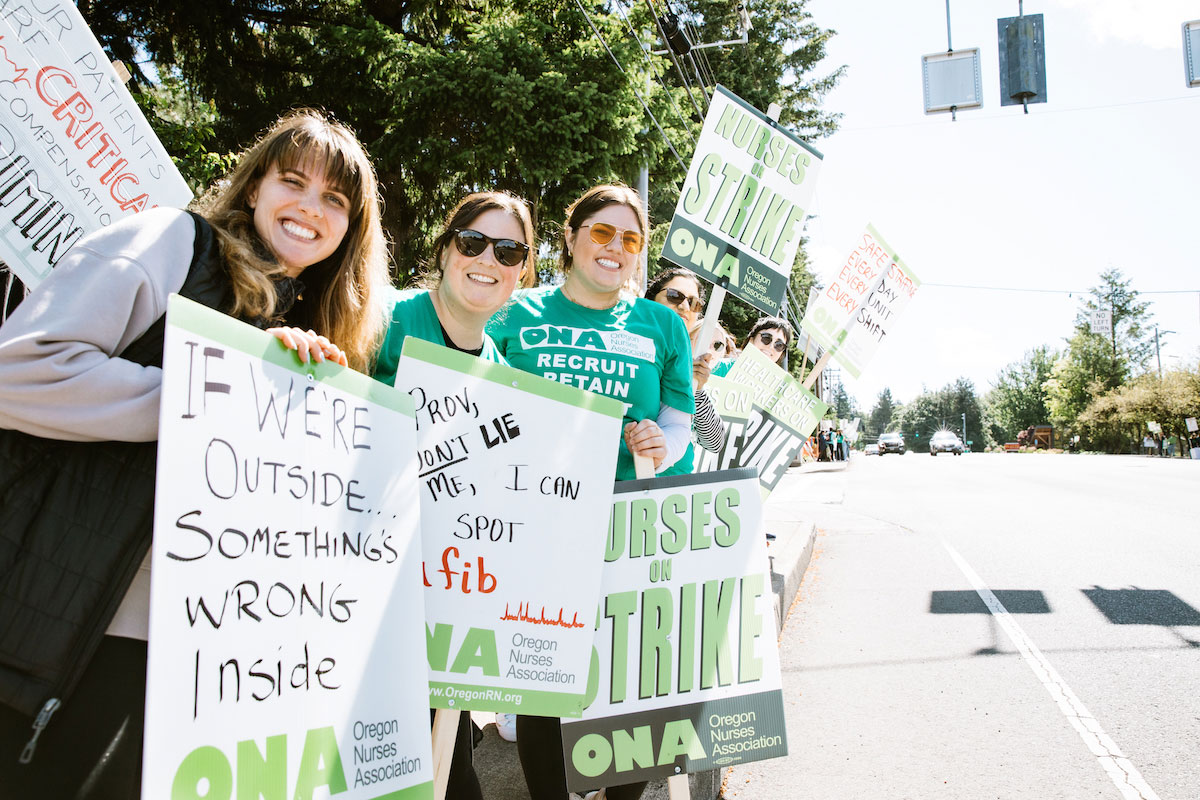Nurses strike at six Providence hospitals

More than 3,000 nurses in Oregon walked off the job and went on strike on June 18. It was the largest nurses’ strike the state has ever seen.
The nurses, members of the Oregon Nurses Association, went on strike at six Providence Health & Services hospitals over low pay, poor working conditions and inadequate health insurance benefits.
At press time, hundreds of nurses wearing green ONA T-shirts – many with green pool noodles – were striking outside Providence hospitals in the Portland, Newberg and Medford areas.
The hospital network hired an unknown number of replacement nurses from around the country to continue caring for patients and reportedly transferred some patients to other hospitals. Nurses represented by ONA at Providence Portland Medical Center are still working after ratifying a separate contract last August following a five-day strike.
“Our hospitals are open and ready to care for our patients,” Providence said in a press release. “We have secured the services of highly trained, experienced replacements who will work alongside our existing nursing staff.”
Outside Providence Milwaukie Hospital, a 77-bed facility south of Portland, several dozen nurses demonstrated Tuesday morning, chanting “Nurses United will never be divided,” playing loud disco music and cheering as passing cars honked in support. It was the first nurses’ strike there since 2003, when newly unionized nurses held a one-day walkout to win a first collective bargaining agreement.
“We want to work!” says Stacy Davis, a registered nurse who works on a surgical ward. Like nurses at other Providence facilities, the Milwaukie hospital is understaffed, according to Davis. Nurses often move on to better-paying jobs at other hospitals, she says.
Pay varies by hospital and the nurse’s experience. For example, a nurse with 10 years of experience at Providence St. Vincent in Portland would earn about $64 per hour. That’s $5 less per hour than the same nurse would earn at Oregon Health & Science University, which equates to nearly $10,000 less per year, according to ONA. For nurses with 30 years of experience, that difference widens to nearly $20,000.
Nurses who remain in Providence are having to take on too many patients or miss breaks and meals, Davis said. A Providence spokesman did not respond to a request for comment.
The nurses had planned to strike for three days, but Providence informed the union that the strikebreakers could not return to work on Friday because they had been hired for five days, so the strike was extended for two days.
ONA spokesman Kevin Mealy said the wage and benefit proposals presented by both sides were very far apart. He said Providence refused to continue negotiating with ONA after it submitted its 10-day strike notice.
At the start of the strike, both sides were focused on patient care. Nurse Hannah Gunderson said Providence Milwaukie managers had hired about 15 substitute nurses on Wednesday. That’s more staff than usual, she said.
The use of substitute nurses is common but controversial. According to KGW, Providence officials have accused the ONA of discouraging substitute nurses from taking jobs in Oregon during the strike. However, several nurses told Northwest Labor Press that they welcomed the help.
“In health care, this is a unique situation. We can’t stop making a widget. These are people. That’s why the replacement workers are necessary,” said Katie Moslander, a nurse in Providence St. Vincent’s orthopedic department. “I really hope they have enough striking nurses to take care of our patients,” she added.




